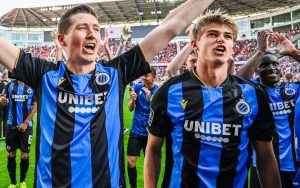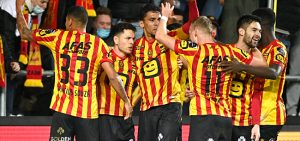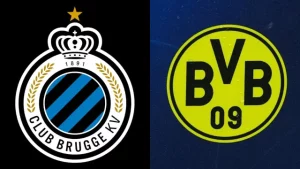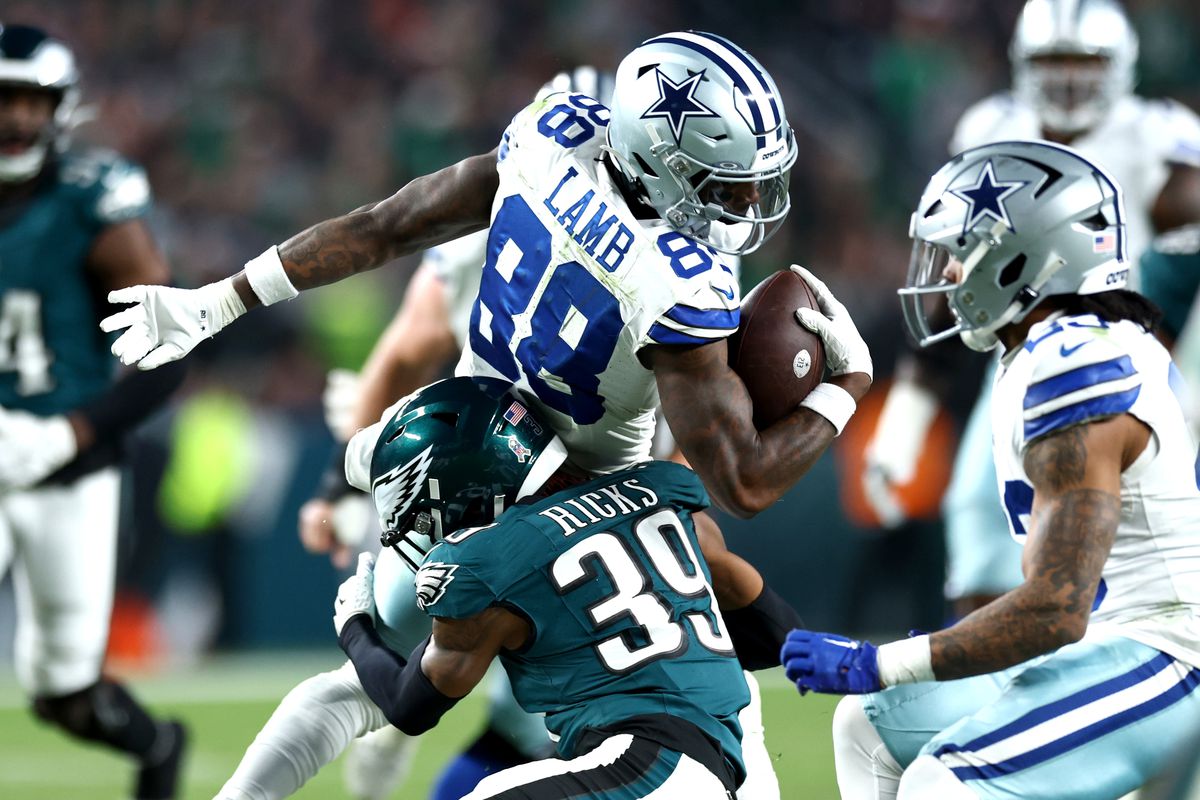
Dak Prescott leads Dallas Cowboys past Philadelphia Eagles

ARLINGTON, Texas — As Dak Prescott stepped to the podium after the Dallas Cowboys’ 33-13 win against the Philadelphia Eagles Sunday, a clattering of fans chanted, “MVP! MVP! MVP!” through the glass from one of the club areas at AT&T Stadium.
Prescott threw for 217 yards on 24-of-39 passing with two touchdowns and no interceptions. He ran three times for 11 yards.
And yet, Prescott did not feel like his performance was up to his standard.
“Solid enough to get the win,” the quarterback said. “I’ve told you before, I’m my biggest critic. Obviously, not my best game. … Did enough to win, but I always want to do better.”
Cowboys owner and general manager Jerry Jones was a little more forgiving.
“Dak Prescott, for anyone that might have a question about it, for him to come in here and play like that against Philadelphia, he should have his due,” Jones said. “That ought to shut that door of questioning his ability to play in a playoff-type game.”
Those questions will continue until Prescott wins big in the playoffs. He has a 2-4 mark in the postseason and the Cowboys have not gotten past the divisional around of the playoffs.
But Prescott is in the best stretch of his career with 23 touchdown passes and just two interceptions in his last eight games. He has thrown at least two touchdown passes in each of the last seven games, tying a team single-season mark held by Tony Romo.
In the last six weeks, Prescott’s odds of winning the Most Valuable Player have gone from 60-to-1 (12th best) to a league-best +175, according to ESPN BET.

“First of all, as far as what it represents, which would be his importance to the team, he doesn’t have to win that award for me to know how important he is to our aspirations this year, where we are and where we’ve got a chance to go,” Jones said. “He’s got that kind of appreciation from I think everybody in this organization.”
Prescott leads the NFL with 28 touchdown passes. He has been intercepted just six times in 13 games after tying for the NFL lead last year with 15 despite playing in just 12 games. Prescott, however, could not get over a sack-fumble that led to the Eagles’ only touchdown of the game Sunday.
“It’s a feeling that sucks,” he said.
But he rebounded from that to lead the Cowboys to three field goal drives after the turnover and completed nine of 12 passes for 109 yards.
“I hold myself to super-high standards,” Prescott said, “and, yeah, if I play my best game, we’re putting up 50 out there. So that’s not going to change, and I’m going to keep pushing for that. That’s the work that I put into this thing, the preparation that I do.”
At 10-3, the Cowboys are in first place in the NFC East, holding a tiebreaker edge over the Eagles, however if both teams win out Philadelphia would lay claim to the division title and earn at least one home playoff game. The San Francisco 49ers (10-3) hold the No. 1 spot currently in the NFC with their wins against the Cowboys and Eagles.

The Cowboys play three of their final four games on the road, including next week at Buffalo and on Christmas Eve at Miami. If Prescott can continue to direct the Cowboys to wins, he could be in line to be the franchise’s second MVP winner. Hall of Fame running back Emmitt Smith won the award in 1993 on his way to helping the Cowboys to a second straight Super Bowl.
Prescott’s goal is not an MVP award. It’s winning a Super Bowl. It’s something he said he thinks about every day. So does Jones.
“Dak is a player who is qualified in every way to have a Super Bowl in his career,” Jones said. Was Frank Gore the Last NFL Running Back?
It’s late in the game, late in the season, late in his career, but he’s still hungry for the ball, so he gets it one more time. He’s a Jet now, his uniform the color of algae, but his jersey number, 21, is what he started with five teams ago, and it still means something. The play calls for him to go off-tackle, such a signature play it might as well be designed for him. There is no hole, but that’s nothing new — he has played for at least as many bad teams as good ones. There is no hole, but Frank Gore knows exactly what to do.
It’s 2020, and Gore signed his one-year deal with the Jets to back up Le’Veon Bell and to mentor the Jets’ young backs. But Gore has never backed up anybody. So he did what he always did, show up sharp at training camp and go to work. Bell is long gone. Now Gore leads what might be the worst team in the NFL in rushing. The Jets won their first game 14 games into the season, against the Rams. His coach, Adam Gase, is facing criticism for giving an old man like Gore all the carries. Shouldn’t he be developing his younger backs? Why Frank Gore? Gase has a simple answer: “I hate to say this, but Frank was 37 years old and the best player on the team.”
He’s hurt when he gets the ball. Like, really hurt. Like, he has suffered a lung contusion and should be going to the hospital. But he has already carried the ball 13 times for a hard-won 44 yards and there’s no way he’s coming out now, not with the Jets ahead by four points. He has practically gained his yards by inches — 1, zero, 6, 5, 7, 2, 7, 2, 3, 5. He has lost 2. He has gained 3, 4, 3, 7. Now, on second-and-9, with eight minutes and 51 seconds to go in the game, he gains 4. He doesn’t so much run as burrow — 3 of those yards seem to be on his belly. But it’s 4, all right, and he takes himself out, a few players on the sideline greeting him and patting him on the pads.
No, it hasn’t been much of a season; but then again, it’s his 16th season. It hasn’t been much of a game; but then again, it’s his 241st game. And it isn’t even much of a run; but then again, it’s his 3,735th run, and by God it’s in the books. He wants to go back in, but the doctors won’t let him. Nor will Gase, no matter how much Gore pleads and cajoles. “I’m like, ‘Bro, you have the greatest career stat line ever,'” Gase says. “I’m like, Bro, you’re not going back in — this is the football gods saying you did it right.'”

The season before — with the Bills, his 15th — he had become the third-leading rusher in the history of the NFL, behind only Emmitt Smith and Walter Payton. He began the game against the Browns with 15,952 yards. The 4-yard run with 8:51 on the clock gave him 16,000 yards “on the nuts,” as Gase says — the greatest final stat line ever. And it stays that way. Indeed, it will stay that way forever, for almost certainly the third man to amass at least 16,000 yards on the ground will also be the last.
The realities of the modern NFL have conspired to discount the value of running backs across the league and across the entire culture of American sports. It’s not just that there are no active running backs who can keep running for 16 seasons; there are no teams that will pay them to do such a thing. Gore is the last of his kind — the Last Running Back because running backs, once gods, are now considered mere foot soldiers. But that proposition raises a host of questions. Is he the last of his kind because he was actually one of a kind? Was he one of the gods or just the ultimate foot soldier, a grinder who never transcended the trenches? And if he is, in fact, singular, what’s that like for his successors? And what’s that like for his namesake — Frank Gore Jr.?
IF YOU WATCHED FOOTBALL over the past 20 years, you probably had the Frank Gore Experience. It probably came when football was just what’s on, when you were watching an off-market game on a Sunday afternoon without knowing why. Someone caught your eye, a hammer of a man, a relentless runner who pumped his knees high yet stayed low, making his living running the ball between the tackles and catching it in the flat, not so much gaining yards as accumulating them — 3, 2, 3, 5, 16, 8, 8, first down, touchdown. When the play-by-play announcer mentioned his name — often calling him “ageless” or just “well-traveled” — you sat up. “Frank Gore? Frank Gore is still playing? I didn’t know he was still alive.”

Last December, I was in a hotel room, away from home, working, just watching what’s on, and what’s on was the LendingTree Bowl in Mobile, Alabama. The game pitted Southern Mississippi against Rice, and Southern Mississippi had a back Rice couldn’t stop. He was short and squat, but his hips had swivel and his legs had spring and he found wayward angles, and he ran low and when all else failed he ran into the tacklers who were trying to run into him. He was in the process of gaining 329 yards on 21 carries, and his name was Frank Gore Jr. I sat up. “Wait — Frank Gore … Jr.?”
He could only be Frank Gore’s son. But that seemed impossible, for there is no such thing as generational overlap in the lives of running backs. This was 2022. Gore finally retired in 2022. He was 39 years old. He began his career in 2005, his counterparts lifers such as Larry Johnson, Clinton Portis, Willis McGahee, Jamal Lewis and Corey Dillon, or else Hall of Famers such as Curtis Martin, LaDainian Tomlinson and Edgerrin James. He ended his career as the emblem of an unlikely and nearly outdated ideal — the running back who sacrificed his body for a body of work and whose fame rests in the fact that he never rested.
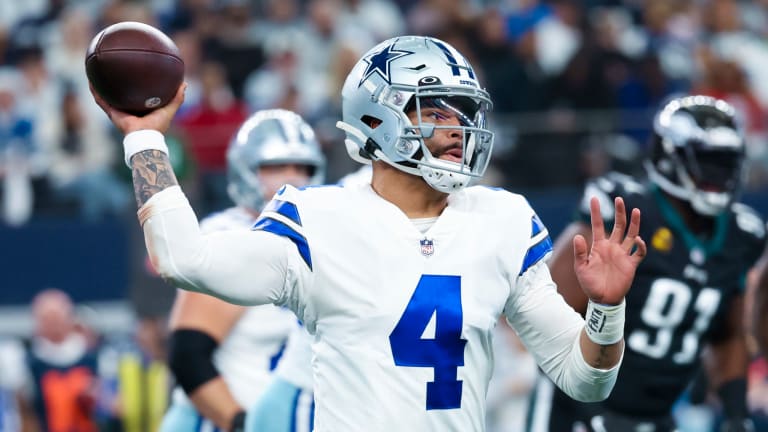
We hear again and again that the average career of an NFL running back lasts less than five years, the bleak actuarial reality becoming such an article of faith that we lose faith in the backs themselves — witness the annual outcry of fans whose team chooses a running back in the first round of the NFL draft. We are told that the job is short-lived as a result of the punishment each running back must absorb as well as the game’s relentless movement from the ground to the air. But the position-wide devaluation is also a matter of money, an economic model that deems running backs not just injury-prone but expendable. There are no old running backs in the NFL anymore, and precious few in midcareer. There are mostly young backs — fresh legs — who are increasingly unlikely to receive contract extensions, increasingly unlikely to get paid. Last summer even some of the greatest backs of our time, Josh Jacobs and Saquon Barkley, received franchise tags instead of long-term contracts, leading their peers to take to Twitter in aggrieved solidarity: “At this point, just take the RB position out the game then,” wrote the Titans’ Derrick Henry. “The ones that want to be great & work as hard as they can to give their all to an organization, just seems like it don’t even matter. I’m with every RB that’s fighting to get what they deserve.”

Gore fought against economic obsolescence just as tirelessly as he fought against opposing defenses and the inevitable injuries. “When you turn 28, you’re going to hear as a running back, you’re declining,” he says. “You can have a f—ing 1,300-yard season, you declining.” As a young back, Gore had a 1,695-yard season with the 49ers. As a midcareer back, he gave the 49ers four straight seasons of more than 1,100 yards and excelled in the playoffs and the Super Bowl. And as an old back … well, a lot of backs get better as games go on. Gore got better as his career went on. If he was one of the best backs ever to play the game over the age of 30, he has that distinction all to himself over the age of 35, averaging 4.6 yards a carry with the Dolphins in 2018. If Derrick Henry, the John Henry of today’s NFL running backs, wanted to match Gore’s yardage totals, he’d have to gain almost 7,000 more yards. When Christian McCaffrey, now the highest-paid back in football, recently became the first 49er to gain 1,000 yards since 2014, the back whose milestone he matched was Gore, who gained 1,106 yards in his 10th freaking season.
How did he do it? In a world where billions of people wonder how to get out of bed in the morning, how did he keep hurling himself into the breach, not quite an immortal but simply a man intent on facing down his own mortality? When asked that question, even people who know Gore best struggle to answer, settling again and again on the same word: “Frank is unique.” But even as a casual fan I could see that, which is why it was so startling to turn on the LendingTree Bowl and see Frank Gore Jr. tearing up the Rice Owls.
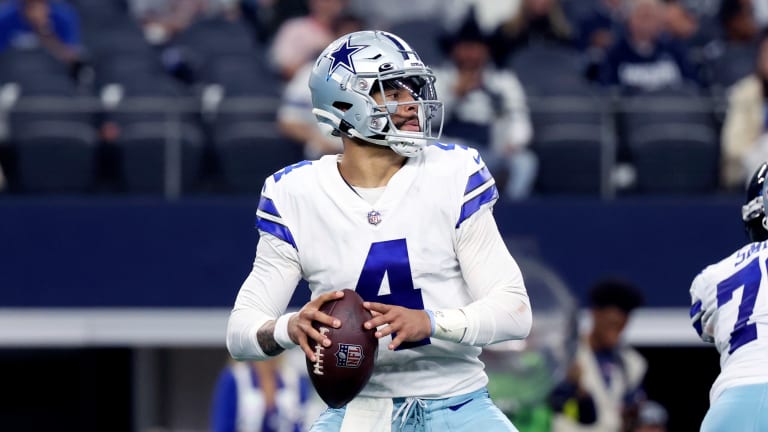
Wait — there’s another Frank Gore? To say that Frank Gore is unique — a singular figure who had a singular career — is to say that following in his footsteps is futile; to realize that he’s, well, a dad, tells a completely different story, because footsteps, by nature, demand to be followed. His son not only saw his father from the stands and on television. He sees him every time he looks in the mirror, and so his tutelage gains a special force. “I understand where he’s coming from, and I also see it in my face,” says Frank Gore Jr. “So, it’s like I know it’s just not something he’s making up because it’s in my face as well.” The question of how Gore did it now sits alongside the question of how he teaches it, and what can and can’t be learned, and what can and can’t be passed on from father to son. Gore had to know something to have had the career he had in the most perilous position in sports — he had to have trade secrets, a body of knowledge, a Tao. But, like all predecessors — like all fathers — he had to have … secrets, unspoken mysteries that informed the mystery at hand. And watching Frank Gore Jr. run roughshod over Rice, I wanted to know what they were.
THAT’S FRANK GORE, all right, at a restaurant near his home west of Fort Lauderdale. He’s wearing a gray hoodie, and he has both forearms planted on the bar. His elbows flank him, as if he’s clearing space for himself, and his hunched shoulders are low, about the same level as the bar rail. His thumbs might be working the iPhone propped in front of him and the light from the screen might be shining on his face, but you couldn’t get a clean shot at him if you tried.
I take a seat at the corner of the bar, between him and his agent. I have been told he’s quiet; I have been told he’s very serious; I have been told he can even be sullen. He is an imposing man, although not physically — he was listed, when he played, as 5-foot-9; his body is described by his high school coach as “roly-poly”; and the way he compresses himself, keeps himself coiled, makes him appear almost shy, self-effacing. What’s imposing about him is his watchfulness, his wariness and his patience. He holds his phone as close as a guy playing high-stakes poker holds his cards, and I get the feeling he’d be comfortable sitting for the next two hours without saying a word.
But that’s not what happens. Although he’s been retired an entire year, in the mornings he is still training hard, as though holding out for the prospect of more — one more run, somewhere. He’s going back to the University of Miami to get his degree and fulfill his late mother’s dream for him. There, he’s taking a course on autobiography. He has already started telling his story to a friend for the purpose of writing a book, and his coursework has sharpened his interest and his determination. I ask him if he has a title. He doesn’t know yet. “Nine Miles,” I say. “What?” he asks. “You ran for 16,000 yards in the NFL,” I say. “That’s 9.09 miles.”
This is news to him, but he doesn’t move a muscle and his smile is barely visible. He still holds his phone close, with his elbows out. Yet something passes through him, and suddenly it’s as if he has gone from playing poker to rolling dice. “Those 9 miles — I had the will, man,” he says. “I wasn’t going to let no one break me. If I set out to do something, I’m going to do it.” Now he wants to share the video clips he has on his phone, and he uses his elbows to signal when I should take a look. He has a lot of video clips, not just of him and his son but also of other backs, whose work he examines with a jeweler’s eye. Derrick Henry? “He so big, he just lean on people. He’s a baller, though.” Bijan Robinson? “A little stiff in the hips, but he got good feet. He gonna be a good back.” Najee Harris? “He never got 4 yards a carry. How do you not get 4 with that team?” The man who is supposed to be so quiet has an opinion about everything and everyone, and when I ask him how he did it — how he ran for 9 brutally contested miles — he talks for two hours straight.
First of all, he had what he regards as the two indispensable ingredients for success as a running back, neither of which is speed or power. “Vision and feet,” he says. “They’re everything.”
Second, he lowered his shoulder. Anyone who was trying to hit him, he hit first. Asked to name the defender who hit him hardest, he answers thusly: “S—, I don’t know, man. Because I don’t really get hit.”
Third, he studied with a kind of mania. When he was a freshman at the University of Miami, he asked his running backs coach, Don Soldinger, what he needed to do to compete with the likes of the players The U had in the backfield in those days — with Clinton Portis and Willis McGahee. Soldinger gave Frank the playbook, and 3:30 that morning his phone rang. “Coach, this is Frank.” “Frank? Are you OK? Is anything wrong?” “No, Coach. I learned all the pass protections, and I want you to quiz me.”
Fourth, he learned about himself. “I feel like every great player study themself,” he says. “If they love the game, they study themself, and every year, when you get older, you’re going to know what you’re losing. I knew what I was losing. I knew I couldn’t get in and out of everything, so I had to put myself in position. I had to be more patient. I used to make sure I knew my aiming points. If the coach said, ‘You have to be outside the tight end,’ I have to make sure I’m there, so if anything break down, I can get out of it. When you’re young, it don’t matter. Your quick twist, it’s there. When you’re young and don’t know the blocking schemes, you run on instinct. Then you get older, it slow you down. You want to know the defenses so you can predetermine stuff. Sometimes it f—s with you. But most of the time, that s—‘s going to hit.”
Fifth, he worked. He didn’t just stay in shape, eat right, show up early and leave late. He did “game-specific” workouts, forcing himself to move his feet faster and faster through smaller and smaller spaces; as he got older, he did them with younger backs, surrounding himself with the freshest legs. But he was also teaching himself how to compete with them, while at the same time putting them on notice. It didn’t matter how old he was, or how young they were. They still had to beat him.
And sixth, he conceded no carries. He claimed them and he was greedy for them and he didn’t care whose feelings he hurt. “Yeah, bro, I ain’t want nobody taking none of my reps,” Gore says. “Nah, f— that, that’s my s—, bro. That’s why I wasn’t scared of nobody, like competition. I ain’t scared of s—. As long as I can compete every day, I’m going to win. I’m going to win.”
EVERY DRAFT DAY, there is a lot of excruciating analysis about the “length” of certain prospects, their times in the 40-yard dash. There is also an almost diagnostic measurement of their motivation — of the size of “the chips on their shoulders.” Well, Gore didn’t have a lot of length. But his chip was about 5-9 and 212, and when he arrived in San Francisco in 2005 as a third-round draft pick, he met Kevan Barlow, the 49ers’ starting back. “Hey, my backup,” Barlow said. Gore could do a lot of things as a football player, but showing deference to an established teammate wasn’t one of them. “I said, ‘Backup, bro?’ I said, ‘Bro, I’ve never sat the bench playing football. And I hope you not thinking I’m coming to sit the bench. I’m dead serious.'”
He was dead serious. Gore led the woebegone 2005 49ers in rushing as Barlow’s backup. “Second year come, I’m like, Man, f— that. I’m already thinking in my mind, ‘This my s—.’ But you know I’m playing backup. So we in preseason, we play Chicago, right? And Kevan, he don’t play because you know he saying he hurt, so I get to start. So first time we go down, I f—ing score, boom. So that next week come, and we go to practice. They call the starting lineup and it’s 12 people in the huddle. I went in the huddle, I’m like, f— that. I don’t got time. I’m like, This motherf—er faking, man. This my s—, and I’m 12 people in the huddle, bro.
“It took awhile for me to get out the huddle,” he says. “The coach is all like, ‘All right, just get out.’ But Norv Turner was the coordinator at the time, and he liked that s–. So that f—ing next week, Barlow f—ing traded, bro.
Fifteen years later, he arrived in Buffalo as an NFL warhorse. He was 36. The Bills were his fourth team, and the starting back was LeSean “Shady” McCoy, his best friend. It didn’t matter. “Bro, I remember I took it so serious because of how people praised him and downplayed my career,” he says. “I wanted to show I’m a bad motherf—er.” He thought Shady had life too easy in Buffalo; he did his best to make it harder. “When you’re a superstar, a lot of coaches don’t really say nothing to you,” Gore says. “So once I get to Buffalo and the coaches see me and Shady competing, and saw that I can play, then they start questioning stuff he do. I remember one time we was in a meeting in training camp, and he didn’t hit a hole or something, and one of the coaches was like, ‘Shady, you should’ve took this.’ And Shady started going back and forth with him. And I was like, ‘F— that, coach. Give that b—- to me.'”
The Bills wound up giving it to him 166 times, and Nov. 24, 2019, in a game against the Denver Broncos in Orchard Park, New York, he gained 6 yards and passed Barry Sanders as the third-leading rusher in the history of the NFL. After the game he received a congratulatory phone call from his old rival in San Francisco, Barlow. “He hated me, bro,” Gore says. “We used to about fight and everything. But I don’t want to knock him because he called me and said, ‘I’m going to be real with you, man. I treated you like that because I knew you was better than me.'”
The Barlow and Shady stories are separated by 15 years and over 15,000 yards. They are separated by time and toil, as well as a broken hip and a couple of broken hands and two rounds of ankle surgery. They are separated by the blood and, well, by the gore. But they are the same story because they are both about Frank Gore. “How did you do it?” I ask him at the bar, thinking it a complicated question since what he’d done was just about impossible. But he has a one-word answer that was the underlying truth of all the others.
He touches his finger to his temple.
“Mindset.”
FRANK GORE DID NOT RECEIVE his surname from his father because his father wasn’t around. He received it from the woman who bore and raised him, the woman who made the name and the mindset inseparable. Lizzie Gore was the most powerful presence in her son Franklin’s life because she pushed him to the front and made sure people saw him. She was as fierce and protective as she was poor and, for most of Frank’s life, sick. She brought up Frank in a one-room apartment in Coconut Grove. There were 12 of them in one place — some her own and some part of her extended family and some simply in need of a home. “Beds pushed up against all the walls,” Frank says. When he was 5, she took him to the local park and altered his birth certificate so he could play Pop Warner. He knew right away what he was running for and running from, and wherever he played, he could hear her voice in the crowd. It didn’t matter if he was playing in the park or playing at the Orange Bowl for the University of Miami, it didn’t matter how loud everyone else was. He was a mama’s boy, and her voice told him where to look.
Lizzie’s kidneys failed when Frank was a junior at Coral Gables Senior High School and already a star. She went to the hospital for dialysis, and he went to visit her. He hated hospitals, but he needed her blessing. “We was about to play the playoff game, and my coaches didn’t know how I was going to be and how I’d react,” he says. “So I just went to the hospital, and my mom was in ICU, got tubes and all. And she told me, ‘Son, I want you to go play.'”
She lived for seven more years. She was able to attend one of his games in his first year as a 49er, against the Jaguars in Jacksonville. But in the summer of 2007, he went through training camp without hearing from her. “So I call my sister to see how Mama was doing,” he says. “But they was lying to me — ‘Oh, Mama good.’ She was at the hospital. I didn’t know how bad off she was because they wanted me to focus. And I didn’t feel right, you know? It had to be God or something, bro. And I’m like, ‘Man something got to be up. I haven’t talked to my mama.’ And I felt it, and I’m driving, and I just broke down crying in my car.”
He flew home to Miami so he could see her before she died. “I walked in the hospital and couldn’t believe that was my mom. Bro, I just couldn’t believe it.” He was at her bedside the last time she opened her eyes, and he spoke to her when she closed them and fell into a coma. He returned to San Francisco, and one day after learning that his mother had died in Miami, he traveled with his team when the 49ers played the Rams.
“The week she passed, everybody was like, ‘You need to go home.’ And I’m like, ‘Why am I going to go home?’ I knew she would have said the same thing if she was in the hospital and fighting. She would have told me to play, and that’s when I made the decision. All right, I’m going to stay up here this week and I’m going to just fight it with you.
“At that game I had to dig deep. It was like I was in a dream, bro. Especially because my mom would call at a certain time to talk to me before the game. Tell me, ‘Go play your heart out.’ And now I didn’t get that call. I went in the bathroom by myself and just broke down. I had to keep talking to myself. I said, ‘Come on, man. You decided to play. You know Mama wants you to play.'”
The video is on his phone. The 49ers are playing the Rams on Sept. 16, 2007. It’s the third quarter, and they’re behind 13-7. They’re on the Rams’ 43, fourth-and-1. Gore, No. 21, takes the handoff, then takes the hole. Boom. He runs into a bunch of players milling around at the line, players who seem nonchalant by comparison and unprepared for the encounter. He is stopped, and then he is not. Boom. He hits a linebacker before the linebacker can hit him. He is stopped again, but then he is free, a plugger turned into a gazelle, his shortish legs stretched by the incredible amplitude of his stride, his chunky 212-pound body angular with swivel as 20 or 30 yards downfield he splits one last clump of human convergence and runs like a dancer into the end zone.
It is the run to watch if you think Gore’s yardage totals came simply as a result of his ability to hang around. It’s also the run to watch if you want to understand the other 3,474 runs, in that it is beyond understanding, his zigs as illogical as his zags are inexplicable, his way lit not just by willpower but by the jagged lightning of inspiration. Even he doesn’t understand, and so he rewinds the video to the point of initial contact, that first shredded scrum. “Look at that,” he says. “Boom. How did I get out of that? Yeah, that was my mama, bro.”
HE COULD START his autobiography anywhere. He could start with the first or last of his 16,000 yards, with the first or last of his 100 touchdowns, or with the brute fact that he played more games than any other back in the history of the NFL. He could start with Lizzie sneaking him into Pop Warner or telling him from her hospital bed to go play or guiding his feet through the circuitous 43-yard run he dedicated to her memory. He has won the right to start with one of the milestones. But the more he has thought about it, the more inclined he has become to start at a moment when he thought it was all going to go away — at the beginning he thought was an ending.
He always knew where he was running, even when he was a kid. He was running downhill, he was running north-south, and he was running straight out of the hard parts of Miami. Lizzie agreed, and so after a senior year at Coral Gables Senior High when he ran for 2,953 yards and set records for Miami-Dade County, she gave her quiet assent when he committed to the University of Mississippi. But The U was not done and still had an advantage in Curtis Johnson, a coach who had watched Gore playing at the park. “I got in my car and drove to his house,” Johnson says. “I said, ‘You’re not going to Ole Miss.’ He said, ‘Yeah, Coach, I’m going.’ I said, ‘Reason you going is you don’t want to compete with the backs we got. You don’t want to compete with Clinton Portis and Willis McGahee. You scared.’ He said, ‘That’s not it, Coach. I said, ‘Well, look’ — and there was his mother. She was a great lady. Oh, she was strong. But she was sick and she wanted him near her. So I was like, ‘How you going to leave your mother? How you going to leave all this?'”
Gore stayed in Miami and not only competed with one of the greatest collections of running backs college football has ever seen but also developed a system with Portis, the starter, that gave him playing time. “He came in and right away we had that bond, that friendship — we got really close,” Portis says. “So every time I came off the field, I’d tell Frank to make sure he was standing with me on the sideline. And as I’d walk off the field, I’d step on the back of my shoe and make it come off, and I’d take my time putting it back on so Coach would put him in.”
Gore ran for 562 yards on 62 carries as a freshman in 2001, and when he remembers that edition of himself, he thinks he ran like Marshall Faulk, “long speed, breaking tackles,” 9.1 yards a carry. In spring practice, Portis had gone on to the NFL draft, and Gore ran with the first team until he made one of his impossible cuts in a routine drill. He had been untouchable that spring, but after colliding in practice with safety Sean Taylor, he immediately grabbed his knee. It came apart so comprehensively that the surgeon, John Uribe, had to address what he saw as a structural susceptibility to injury, “the small notches” tying his ligaments to the bone. Gore never ran like Faulk again. He was too poor at the time to find transportation to the therapy he needed and never regained full extension of his right knee. “Frankie lost that step,” Don Soldinger said. “But he never lost his vision and could pick his way through things.” His style changed, and at the same time so did his life. He was just 18 years old, and on March 13, 2002, six days before he wrecked his knee, Frank Gore Jr. was born.
It is another part of the Frank Gore Experience: Wait — he did all that … hurt? Turns out, he might have been durable, but he was never invulnerable. Turns out, he was sort of injury-prone. Turns out, he blew out his left knee in 2003 — those small notches again, costing him a second step — and went to Soldinger in tears, telling him he was done, until Soldinger responded that his talent was God-given, and it was Soldinger’s mission to get him to the NFL. Turns out, he was not only the best old back in NFL history but also the best injured one. Turns out, his story is not about an invulnerable man at all but rather a man who as a child, as a boy, as a high school student, as a football player and as a father knows that he is vulnerable and has spent his life figuring out what to do about it.
HE WAS JUST IN MIDDLE SCHOOL. A woman pulled up to the apartment in Coconut Grove to pick up one of his cousins. Her name was Sharon Krantz, and she was his cousin’s guidance counselor. She was not Frank’s, but he walked up to the car and tried to get in. She had heard about him — “I really didn’t like Frank because he was always in trouble and a little bit of a crybaby.” She locked the door. Then Lizzie came outside and began yelling at Frank to get in the car and go to school. “She won’t open the door,” he answered. A stalemate ensued: “He’s turning around to go back to the house and she’s yelling at him to get in the car,” Krantz says. “So I opened the door, and I let him in.”
He started showing up at her office to talk to her. He began getting in trouble to talk to her, although that was not the only reason for his misbehavior. He couldn’t read. “I was getting into trouble because I didn’t want to get picked on,” Gore says. “I didn’t want to read in front of people so, OK, I’ll go make problems.”
He began calling her what he calls her to this day: “Miss.” She in turn recognized him as the kind of young man the public education system routinely discards, a casualty in the making. When one of his teachers told him he would amount to nothing, he would have taken the damning judgement entirely to heart if not for football. It was all he talked about with Miss Krantz, and so one day she gave in and went to the park to watch him play. She was shocked by what she saw. “Football was like his Superman cape,” she says. She also heard Lizzie talking about her: “There’s that white lady Frankie loves.”
